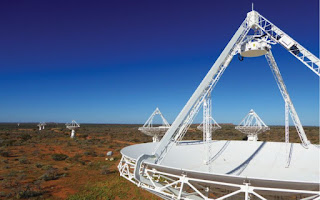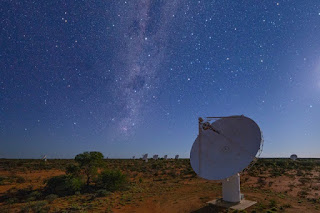Australian scientists claim they have been able to map one million new galaxies using advanced Askap telescopes in the desert.
 |
| Mapping milion of new Galaxy through new Askap telescope- Image/CISRO |
The National Science Agency CSIRO says its new telescope has created "a new atlas of the universe" in record time - showing unprecedented patterns.
Video -Amaze Lab
It maps a total of three million galaxies, with images showing double the level of detail of previous studies, the survey said.
Astronomers hope that these images will open the horizons of new discoveries about the universe.
The CSIRO said the mapping took only 300 hours, compared to many years in previous all-sky surveys.
 |
| Askap Telescope in Australia Desert-Image/CISRO |
According to lead author Dr. David McConnell, data published to the public enabled scientists around the world to study "everything from the formation of stars to the development of galaxies and their supermassive black holes and how they interact."
Related:
[Life on Venus , Scientists Claiming that it may be possible]
“We hope to find millions of new galaxies in future studies,” he said.
Preliminary results were published in the Australian Astronomical Society on Tuesday.
What is the structure of this telescope?
The Australian Square Kilometer Array Pathfinder (Askap) is made up of 36 dish antennas that work together to take in the panorama of the sky.
The system is located in the southern hemisphere, south of Australia and west of Australia. It is spread over an area of 6 km (3.7 mi) at the Mercison Observatory of the CSIRO, about 700 km north of Perth.
Askap telescope in Western Australia
Asap Telescope has a collection of dishes across the deserts of Western Australia
 |
| Night vision of Askap Telescope |
By combining signals from smaller dishes, the telescope creates a high-resolution image at a fraction of the cost of a very large meal, CSIRO said.
The huge amount of data generated at a faster rate than the entire Internet traffic in Australia - is sent to Perth's supercomputer for processing images.
Did you find it?
Escape conducted its first full-sky survey this year, covering 83% of the sky and covering three million galaxies.
Australia has launched the National Space Agency
Using only 903 detailed images, the map is sewn together. Previous surveys required thousands to photograph the entire sky.
Astronomers say the depth and scale were exciting because they had to conduct statistical analysis by listing a few million galaxies from the Milky Way. These can help to understand how the universe evolved and became structured.
Media caption "The moon will help us learn about deep space survival"
The Askap Telescope is a square kilometer array located in South Africa and Australia - one of the forerunners of an international project to build the world's largest radio telescope.
Post a Comment
Don't allow spam link